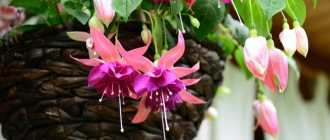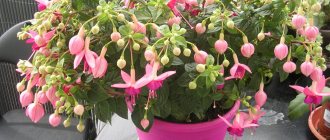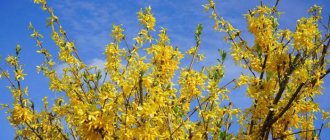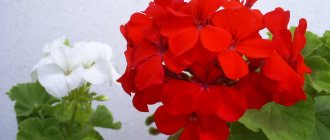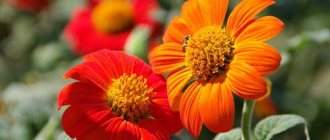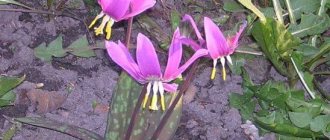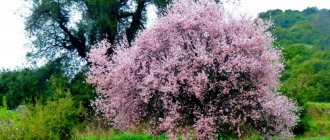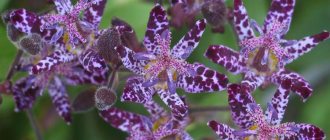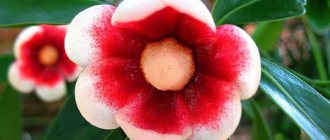What it looks like, what family it belongs to
Fuchsia is an evergreen plant with richly colored leaves that have a pointed oval shape and are arranged in pairs. Branches can be either erect or falling. Drooping flowers. The stem is usually light. The plant belongs to the fireweed family.
Garden fuchsia
Charles Plumier is considered the discoverer; it was thanks to him that the world learned about a new plant, whose homeland is New Zealand, South and Central America.
The scientist discovered fuchsia in the West Indies during another expedition. Since then, the plant has been loved for about 200 years. Fuchsia feels great in the fresh air and allows you to enjoy its view.
Garden fuchsia is a plant that is grown and cared for outdoors. Its bushes are erect, have large flowers, the size of which varies from small to medium. They look great in flowerpots. You can also place fuchsia in flowerpots outside.
This species has the following groups:
- Australian,
- sapphire,
- ampelous,
- terry.
Answering the question whether fuchsia is an annual or perennial plant, experts will say: in general, the flower is a perennial; in its natural environment it grows for more than one year. But in the northern latitudes of Russia, the exotic plant is not ready for wintering outdoors. In such conditions, only some varieties are grown, and in the format of annuals.
Attention! Fuchsia outdoors in summer is most often found in large pots or cache-pots. Such plants are brought into the house for the winter and put away in the basement until spring.
But many people are interested in the question: can fuchsia be planted in open ground? Some gardeners answer in the affirmative and even give advice on growing fuchsia outdoors and caring for it at different times of the year. More details about this will be written below.
Most common varieties
Many modern varieties are characterized by bright color combinations.
Fuchsia Blue Vale
This is a universal variety; it can be grown either as a bush or as an ampel. The snow-white sepals of double, large flowers have a green tint along the edge. The flower's skirt is fluffy and lavender in color.
Flowering is long lasting and very abundant.
Fuchsia Bella Rosella
The plant has some of the largest flowers (10-12 cm). They are terry, bright, lilac-pink with snow-white stamens and pale pink sepals. Flowering is abundant and long lasting.
Fuchsia variety Bella Rosella has an ampelous and bush form. It is unpretentious and can grow in shade.
Variety Bella Rosella
Fuchsia Blue Angel
Blue Angel variety is an exquisite, memorable fuchsia. The flower size is up to 12 cm in diameter. The corolla (skirt) of the flower is double dark lilac in color, the sepals are white. When fully bloomed, white stamens with pink anthers become a spectacular accent. The bush is semi-ampelous (drooping).
Fuchsia Hollis Beauty
The flowers are large (7-8 cm), double, white sepals, lilac-blue skirt. The bush grows very neatly, has a compact shape, and branches well. The variety tolerates heat and bright sun better than other fuchsias.
The flower is elegant, contrasting, white-green sepals set off the purple-pink skirt. Especially good in full dissolution. Pink elongated stamens set off milky white anthers.
Important ! The growing form is ampelous; the lashes of an adult plant grow up to 60 cm in length.
Fuchsia Blue Ice
The plant was obtained as a result of the starting mutation of the Dark Eyes variety in 1954 in the United States of America. Large, double flowers are distinguished by a characteristic arrangement of petals. They resemble a multi-layered petticoat. The color of the petals is deep lavender, the sepals are light crimson. It is interesting that in plants of this variety, flower petals can vary in color intensity. The variety is undemanding; it is grown in bush and hanging forms. Grows quickly, restrictive pruning is recommended to form a dense crown. Feels good in partial shade.
Fuchsia Bicentennial
Fuchsia ampelous Bicentennial is painted in salmon-orange tones. The characteristic magenta strokes along the edge of the multi-layered skirt create an extraordinary color contrast. The flowers are elongated, rather large, in the form of buds. Light sepals become bright orange over time.
The variety was bred by Californian gardener Ted Pasquesen in 1976 and dedicated to the 200th anniversary of US independence. Paskesen carried out lengthy breeding work to obtain a variety that was resistant to heat and strong winds.
The plant forms a dense, branching crown and blooms profusely.
Variety Blue Mirage
Fuchsia Blue Mirage
The plant can be grown as a semi-mounted plant, in the form of a drooping bush and in hanging containers.
Blue Mirage is a large-flowered variety that blooms with deep purple flowers with snow-white sepals. The length of the shoots of the variety is up to 40 cm. Flowering is early, abundant, and long-lasting. The flowers are double and large.
The leaves are medium in size, the stems become woody quickly, so the variety is easy to grow in standard form. The variety is fast growing and winters well. Suitable for growing by beginning gardeners.
Fuchsia: growing and care in the garden
Freesia growing and care at home and in the garden
Fuchsia feels great in the garden in summer. A temperature in the range of 20-25 degrees is suitable for her. As temperatures rise, the leaves may wilt and the buds may fall off. Therefore, when it is very hot, it is better to send it into the shade so that the lighting is diffused.
Fuchsia in a pot on the open veranda
Street fuchsia is relatively unpretentious; even a novice amateur can cope with its care. The main thing is to provide it with protection from direct sunlight and not plant it on the south side of the site. It will be good if, immediately after noon, the fuchsia flower bed is in the shade.
At the same time, complete shade is also not suitable for the plant, as is high groundwater. If the soil on which the flower grows is too wet or cold, the bush will quickly wither.
In general, experienced gardeners recommend planting fuchsias in large pots or hanging structures. In this case, the flowerpot with the plant can be rearranged as needed. Flowerpots can even be hung on the veranda, creating a whimsical decor of beautiful flowering plants.
Attention! Young fuchsia is unlikely to take root in open ground. Experienced gardeners recommend planting three-year-old plants in the flowerbed, which have previously managed to grow stronger in pots.
Watering and spraying
Flower lovers are wondering how to water fuchsia at home when growing in the garden. First of all, you need to focus on the condition of the soil, ambient temperature and time of year. On average, it is worth watering fuchsia at least once every 7 days. However, if the soil is too dry, then watering is allowed once every 3-4 days.
Collection of fuchsias in the garden
Since fuchsia is native to humid tropical climates, it will appreciate being sprayed at least twice a week.
Important! If the weather is hot for a long time and there is dryness in the air, then fuchsia should be sprayed every other day.
It is important to use warm, settled water. It is best to collect rainwater and use it. Tap water is not suitable for flowers at all, as it contains chlorine.
Fertilizers
Regular and timely feeding is very important for this flower. In simple garden soil, without fertilizers, the bush will not bloom profusely, its decorative qualities will be low.
The first portion of substances is added before planting. Humus and phosphorus fertilizers are added to the fertile soil.
Next, fertilizing is distributed according to growth phases:
- At the first stage, at the beginning of summer, fuchsia needs complex fertilizers with a high nitrogen content. This feeding will help the plant strengthen and increase green mass.
- Before flowering, you need to add potassium and phosphorus to the ground so that the bush plant can lay as many buds as possible. This will be the key to colorful and lush flowering.
- To prevent the flower cover from disappearing too quickly, it is better to feed the flower with organic matter. In this case, flowering will be delayed and will please the gardener longer.
Experts recommend alternating mineral and organic fertilizers, adding one or the other every two weeks.
Aftercare
Even after a flower has taken root in a new place, unlike unpretentious plants, it requires special care.
In addition to timely feeding of the plant, care requirements should be met.:
- in especially dry times, you need to monitor the soil moisture and water the flower at least twice a week;
- monitor the condition of the plant so that it does not get sick;
- With the onset of cold weather, you need to take care of replanting the plant in a pot.
If you follow the instructions for fertilizing and care for the flower, then it will definitely delight you with its flowering in the near future. With good care, you can think about crossing species using seed propagation. Thus, you can get a very beautiful flowerbed planted with fuchsia.
Preparation for winter and further care
Fuchsia - growing and care at home
In order for the plant to successfully survive the not entirely favorable temperature conditions of the Russian winter, you should begin preparing for the cold in advance and know the rules for preserving the flower.
Fuchsia in winter
Fuchsia can overwinter in a loggia, on a veranda, or in a greenhouse. You can place it in the basement or in trenches. If the choice fell on wintering in a room, then it needs to be transplanted into a container and placed away from the battery.
First of all, you should forget about fertilizers from the beginning of autumn. But in September you need to prune.
Important! It is advisable to leave the fuchsia outside until the first frost; if you remove it earlier, it will not have time to complete lignification.
Before moving fuchsia indoors for storage, you need to inspect it and get rid of stems and leaves that have dried. It wouldn’t hurt to spray with special preparations to protect against harmful insects and their larvae.
As stated above, growing in pots, flowerpots and flowerpots has its advantages. With this approach, the flower lover simply transfers the containers with flowers to the basement at the end of autumn, where they calmly wait for spring, being in a state of rest.
Wintering in open ground
In the southern regions, wintering fuchsia in open ground is allowed. The plant can survive under the snow if it is well covered with spruce branches. You need to spread the film over the spruce branches to protect the wintering plant from excess moisture.
On the 15th of May you need to start removing the film and giving the plant a chance to breathe.
When and how does it bloom
Fuchsia ampelous - growing and care at home
With proper care, fuchsia blooms every year. Thanks to its wonderful flowers, it even acquired the name “Chinese Lantern”. Flowering time depends on the variety.
Fuchsia blossom
The flowers are drooping and grow abundantly and for a long time. Depending on the variety, there are both small and large, collected in brushes or scattered singly, terry or not. As for color, it varies from soft crimson to a bright, rich purple hue.
The shape of the flowers resembles a doll in a tutu. They grow on long stalks. There may not even be one color, but several (up to three).
This is interesting! Garden fuchsia berries can be eaten, but they cannot be called tasty.
Flowering in general is quite long:
- Trifoliate blooms from May to October.
- Sparkling - all summer.
- Graceful, Recumbent and Waist - from March to November.
- Splendence - all year round.
- Thyroid - from July to October.
- Bolivian - the first two months of spring.
Adviсe
Flower growers with experience in growing garden fuchsia in the summer are advised to concentrate on the following features of cultivating an ornamental plant: different types of garden fuchsia need different lighting intensities, therefore, the flower garden must be placed depending on the needs of the plant; even light-loving species often find it very difficult to tolerate direct sunlight and need shading; in flowerbeds located in very sunny places, the need for irrigation measures is high.
Ampelous and compact species are best grown in flower pots. These types of garden fuchsia will become woody over time, therefore, when growing them, you should continuously monitor the condition of the plant and replace the old bushes with young seedlings fed by cuttings. Suitable neighbor plants for fuchsia grown outdoors include balsams, ivies and begonias.
Trimming
To grow the healthiest plant possible, by winter gardeners usually trim off the withered leaves themselves in anticipation of new shoots in the spring. You should also regularly trim diseased and broken branches.
In the spring, young shoots are cut off by a couple of centimeters if a lush crown of the bush is expected to form. This procedure is carried out twice, with an interval of two weeks.
Plant pruning
Attention! If the flower is grown indoors, then fuchsia needs to be trimmed less often than in open ground.
Some lovers try to form a standard fuchsia by regularly cutting off its side shoots. It is difficult to say how productive this activity is. There are only verbal descriptions of how a small tree was allegedly obtained from a bush. It is impossible to even find photographs of such plants.
Fuchsia transplant
It is recommended to transplant during the beginning of the growing season, that is, in the spring.
Before replanting, you need to inspect the roots for mold. The new pot should have dense walls and be spacious enough.
Attention! It is necessary to have drainage to avoid stagnation of water at the root system.
If we talk about transplanting from a home pot to a flowerbed in the spring, then you should wait until the end of May, when the threat of returning night frosts has completely passed. Fuchsia is transplanted into the garden along with a lump of earth using the transshipment method. In the first two weeks, do not feed, water moderately, and carefully observe how the plant takes root.
Flower propagation
Propagating fuchsia is quite simple, however, in the circumstances of home gardening, such an event is most often accomplished by the vegetative method or so-called cuttings . To cut cuttings, you need to select slightly woody shoots, which then take root in water or sand.
After about a few weeks, a root system appears in the plant, and the new seedling can be transplanted to a permanent position in an open ground flower garden. Bush species can be cut from cuttings once every 3 years, which allows you to refresh the decorating crop yourself. Seed propagation is used for breeding purposes, since when grown from seeds, a plant may lose its parental varietal properties.
However, if there is a need for seed propagation, seed sowing is carried out in March or April using peat tablets for planting. This kind of method makes it possible to carry out replanting without damaging the roots of the crop.
How does it reproduce
Propagation by cuttings is considered the most productive.
Since an adult plant is pruned in the fall, the remaining cuttings can be used for propagation. To do this, it is worth selecting the strongest shoots, preparing cuttings up to twenty centimeters in size from them, removing the lower leaves and placing it in water. The roots will soon grow, in about a week - this is a sign that you can plant the cuttings in a glass.
This is followed by standard care for the first year. Only after this can you try to plant the plant in open ground. However, fuchsias that are so young take root poorly.
Important! Experts recommend keeping the flower at home for three years, taking it out into the open air in the summer. Such a plant will be ready for planting in a flowerbed in about three years.
Propagation by seeds is not so simple. Primarily because it is difficult to obtain material - for this you need to resort to artificial pollination. In the fall you will have to collect the seeds and dry them thoroughly.
To properly propagate fuchsia by seeds, you will then have to proceed as follows:
- Get a container with high walls and moist soil.
- Sow the seeds.
- Cover it with a glass lid.
- Provide access to light for half a day.
Seeds in the ground need to be looked after: the substrate requires constant watering, and the seedlings need to be allowed to breathe a couple of times a day for half an hour.
Possible problems in growing
Although fuchsia is an unpretentious plant, certain problems can still arise with it. To avoid this, you must follow all recommendations for planting, watering and fertilizing. The presence of pests or diseases is easily determined by the appearance of the fuchsia.
- The red spider mite can spoil the plant by entangling the leaves with its web. To avoid the death of the flower, you need to treat the plant with a special product - the Fufanon insecticide.
- The whitefly may lay eggs and the hatched butterflies will feed on the sap of the plant, slowly killing it. To protect, you need to wash with soapy water without touching the roots. The special drug Aktara will be even more effective.
- Standard store-bought insecticides also help control caterpillars, aphids and other pests.
Pests on fuchsia leaves
Problems can manifest themselves both due to improper care, for example, excessive or insufficient watering, lack of light or its abundance, and due to various fungi.
- If the leaves are covered with brown spots, you need to immediately trim them and wash the entire plant with soapy water. If many leaves are affected, then it is better to use Topaz.
- Yellow leaves indicate Chlorosis. In this case, you need to feed the plant with mineral fertilizers with magnesium and nitrogen.
In general, reviews of this plant say that with proper care there should be no problems.
Diseases and pests, methods of combating them
Fuchsias are not very susceptible to disease and love good care. High humidity in the garden carries the risk of powdery mildew. Foundationazole can help in the fight against it. Among the pests, aphids, spider mites, and whiteflies are dangerous. Aphids form noticeable colonies on the outer parts. The leaves turn white, curl, the trunks become bent, and the buds remain unopened. For control, wiping with alcohol, supported by cotton swabs, and further treatment with an insecticide are used.
At low air humidity, the opposite side of the leaves is damaged by colonies of mites in the form of specks; in case of infection, the leaves become discolored, they turn yellow and fall off. It is advisable to spray the leaves more often; treating with insecticides may help. Whitefly causes small spots, yellowing and leaf drop. The plant loses its picturesqueness. Sooty fungus settles in damaged areas. The basis for the fall of leaves and buds is:
- violation of the watering order;
- insufficient lighting;
- sultry air;
- a sharp change in position according to the direction towards the light.
The reason for a short period of flowering in the summer in the garden can be the winter maintenance of the plant in an excessively warm room and violation of watering, insufficient nutrition, light and moisture content during the period of increase. Leaves with brown spots and yellowness along the edges are a sign of waterlogging of the soil.
Types of fuchsias
Fuchsia at Russian dachas comes in different types:
- Bolivian,
- Magellan,
- thin,
- recumbent,
- hybrid,
- graceful, etc.
In the wild, this plant is a perennial. However, in Russian gardens it can only be grown as an annual. There are certain indoor growing species that do not take root very well in the garden. Other varieties can be planted in open ground.
Attention! It is worth clarifying that fuchsia Magellan and brilliant ones look most impressive in the garden.
These varieties will produce large, colorful flowers in the summer. They are tall, bushy, up to seventy centimeters in height. Fuchsia Riccarton and garden perennial fuchsia Graceful are suitable for the southern regions - they can withstand air temperatures down to zero degrees, so they can easily winter in the garden, with good shelter. In this case, the flower lover will not have to carry flowerpots into the house for the winter.
